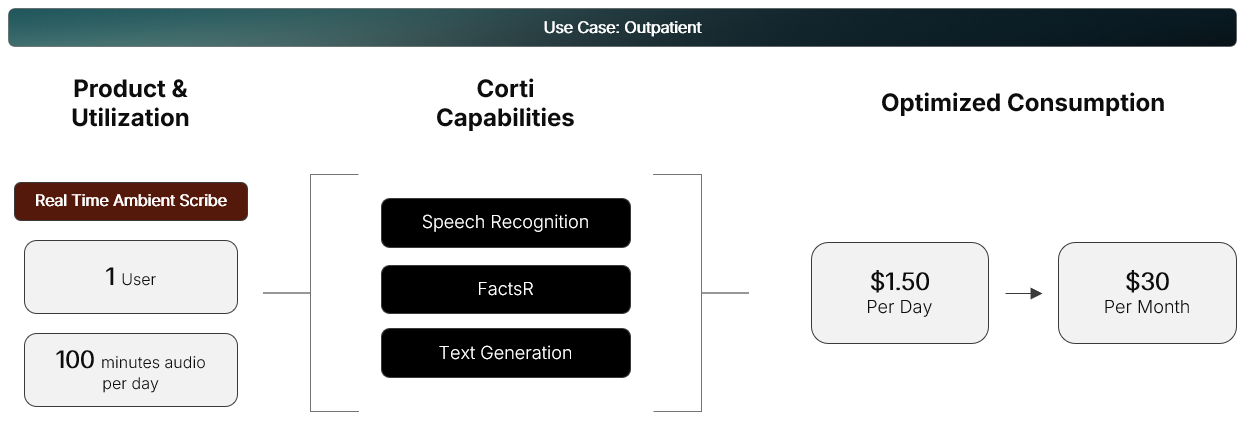Ambient scribes: three use cases built on Corti
From clinic rooms to wards, Corti powers the voice of healthcare

Introduction
Healthcare documentation looks different in every setting — from nurses juggling dozens of quick encounters to psychiatrists documenting complex sessions. Teams building ambient scribes need flexible infrastructure that fits each workflow while guaranteeing accuracy, compliance, and clinician trust.
Here are three real-world examples of how developers are using Corti to power production-ready ambient scribes, along with illustrative cost models showing how optimized consumption keeps performance high and spend predictable.
The examples below highlight how teams are building on Corti — detailing each end customer’s workflow, architectural needs, and the solutions they delivered.
Simple outpatient primary care visit
Typical workflow
A ambient documentation vendor for primary care providers. Their end users conduct focused, time-bound visits covering history, exam, and plan, often under tight schedules. Providers need to capture the full story in real time while staying engaged with patients, avoiding after-hours charting, and generating structured notes ready for sign-off.
Architecture needs
- Accurate capture of medical language like HPI, ROS, meds, allergies, and problem list references
- Ability to generate downstream documentation in the form of SOAP notes
- Clinician-in-the-loop edits that auto-propagate across sections
💡 Illustrative cost example:

Complex psychiatry sessions
Typical workflow
A mental health telemedicine platform developing an ambient scribe for psychiatrists running long, complex sessions. End users conduct 45–50 minute visits with rich dialogue, nuanced emotional cues, and detailed medication management. They need accurate capture of narrative content, structured risk assessments, and longitudinal tracking without interrupting therapeutic flow.
Architecture needs
- Vocabulary tuned for psychiatry: mood, affect, thought content, insight, judgment, suicidal ideation, therapy modalities
- Long-context reasoning to connect themes across the session and past visits
- Speaker-aware attribution for quotes, reflections, and clinical observations
- Prompts for mandatory elements: risk assessment, adherence, side effects, safety plan
💡 Illustrative cost example:

Nurse on a unit, hopping room to room
Typical workflow
A nursing assistant platform building tools for frontline nurses working across inpatient units. Their end users move quickly between 8–10 patients per shift, juggling short, fragmented interactions — vital checks, medication passes, and brief status updates. Each touchpoint requires accurate documentation and context awareness, but without the time or capacity to stop and type. The goal was to capture these micro-encounters seamlessly through voice, ensuring every action and observation is logged in real time while keeping the nurse focused on patient care.
Architecture needs
- Robust context switching with live patient disambiguation from location beacons, badge scans, or EHR context
- Diarization for conversations in multiple contexts, far-field mics, interruptions, and overlapping speakers
- Flexible notion of “encounter” that supports micro-interactions stitched into a single shift record with timestamps
- Fast commands: “Save vitals,” “Log 5 mg oxy,” “Add wound size,” “Next patient”
💡 Illustrative cost example:

Looking ahead
Whether you’re building for quick nursing touchpoints, standard outpatient visits, or long-form psychotherapy sessions, Corti’s infrastructure adapts to every workflow — delivering clinical accuracy, compliance, and production-grade performance at optimized cost.
Stop hacking together generalist models. Build your ambient scribe the right way — with Corti.
